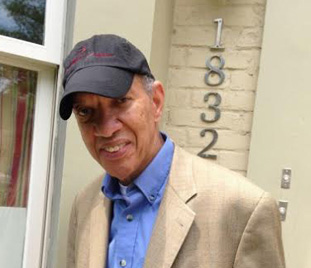
WASHINGTON – In the 1960s, the Student Nonviolent Coordinating Committee (SNCC) helped African American Southerners, who faced terror and intimidation, organize to be allowed to exercise their right to vote.
The work was tedious, frustrating, exhausting and dangerous.
Ivanhoe Donaldson taught many of us how to do it.
SNCC organizers, mostly black Southerners themselves – with some black and white folks from the North – worked to support thousands of “everyday” heroes who risked everything for equality and justice. Your name and address was put in the paper if you tried to register to vote. If you were African American, you could be beaten, have your house burned down, your mortgage called in, be fired from you job or be put off your land.
Donaldson, born in Harlem and raised in the Bronx, the son of an African-American New York cop, went South and helped black people from Mississippi to Virginia face the dangers and join the Freedom Movement.
Before the Selma march, Donaldson was in Alabama helping to organize the Lowndes County Freedom Organization, whose members adopted as their symbol a Black Panther. Later it was used, with permission, by the group who organized in Oakland, California.
After his work in SNCC, Donaldson helped change the color of American politics by helping black candidates across the nation win offices for the first time.
He was one of the first leaders to recognize the untapped electoral power of the District of Columbia’s majority black population and helped transform the District from a somnolent, subjugated colony into a progressive community able to continue its fight for full home rule.
Donaldson was a brilliant organizer, an astute political tactician and a fearless fighter for equality.
Like Bayard Rustin and Ella Baker, he was part of the Movement backbone. He helped shape its direction, but felt his role was to help others become visible leaders and spokespersons.
If you haven’t heard of him, you will. His story will be told as the true history of the Civil Rights Movement continues to be written.
Top trainer
I first meant Ivanhoe in 1964. I had been an organizer for SNCC since ’61 and had been sent to Holly Springs, Mississippi, where I worked alone for many months before a group of volunteers and an experienced project director, Ivanhoe Donaldson, arrived.
I was expecting a director who would be, like most SNCC leaders, armed with little more than great faith.
Ivanhoe came armed with a map of the counties surrounding Holly Springs and lists of black residents. “You can organize any community,” he said, “if you have a map.”
Working with most SNCC leaders, you did about one hour of work for every three or four of introspective discussion. Ivanhoe was different. He took charge and put us on a vigorous work schedule. He was blunt and brooked very little back talk from naïve volunteers who thought they knew it all from books and television.
Ivanhoe expected results. We loved and respected him and felt safer with his leadership.
Once, when he and I were arrested on some trumped up charge, the sheriff brought us into a holding area surrounded by deputies with billy clubs. He moved to smack us.
Instead of using the standard, passive, nonviolent technique of protecting his head, Ivanhoe took control of the situation just as he had taken charge of the project.
“If you hit me,” he yelled at the sheriff, “I’ll sue you for so much, you’ll have to sell your wife.”
I was sure we’d be killed.
In the segregated South, death was a common punishment for a black person talking that way to a white man, especially if the white man was the sheriff.
In this case, however, the sheriff was so flustered, so sure he had run into something that was threatening beyond his understanding, that he quickly put us back in our cells.
In other instances, Ivanhoe’s courage in expressing his anger to racists was truly life threatening. His close friend Harry Belafonte taught him to control it.
Ivanhoe became the quintessential SNCC worker. The group made a training film featuring him, called simply Ivanhoe.
Assertive with SNCC staff and volunteers, Ivanhoe was low key with local people. He worked patiently to encourage blacks to take the courageous step of attempting to register to vote. He would sit for hours on porches, talking and listening. At other times, he sat among worshippers at church, enthusiastically singing hymns.
Ivanhoe helped guide SNCC from being a protest group to becoming an organization leading African-American communities in struggles to gain genuine political power.
Political strategist
After SNCC, Ivanhoe helped usher in a generation of black political leaders. As his campaign manager, he helped Julian Bond become one of the first blacks since Reconstruction to serve in the Georgia legislature. He helped Richard Hatcher become the first black mayor of Gary, Ind., and advised black candidates around the country who were running for local, state or federal offices.
Courtland Cox, a top SNCC leader, said, “Ivanhoe understood electoral politics before any of us did. He knew the numbers and how the game was played.”
Along with many former SNCC organizers, Ivanhoe moved to Washington, DC while it was still officially a “department” of the federal government. He helped District residents get the right to elect their own city government.
The first mayor under “home rule” was a holdover from the days of federal control. It wasn’t until Ivanhoe led and won Marion Barry’s mayoral campaign that DC came closer to becoming a self-governing city.
Barry, who’s gotten a raw deal in the national press, became a skilled politician able to relate to and bring together disparate District communities. But it was Ivanhoe who learned how to get thing done.
He served as Deputy Mayor and in other capacities, and it was commonly said that “Barry could talk the talk, but it was Donaldson who walked the walk.”
In recent years, Ivanhoe suffered from cancer and Parkinson’s disease. As he grew weaker, he was too proud to allow his friends to feel sorry for him. He kept them away.
However, two weeks ago his partner put her foot down and insisted Ivanhoe allow some of his close friends from his SNCC days to visit him. They chatted for a long while and then someone suggested they sing Freedom songs.
As weak as he was lying there in bed, Ivanhoe took charge. He would not allow the singing. Not because he didn’t like the songs but because he knew no one there could live up to his standards for good music.
Ivanhoe passed away a few hours later, Sunday morning, April 3.
His phone kept ringing with people who did not know he had died but who wanted advice on a wide range of subjects.
Photo: Ivanhoe Donaldson, 2014, Zinn Education Project.












Comments